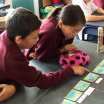Understanding speech, language and communication needs
Communication is much more than words. It is the way we connect with people. It is part of our identity and culture. It helps us to learn, interact with others and to make friends.
On this page:
On this page:
Current page section: Understanding speech, language and communication needs
Go to top of current page: Understanding speech, language and communication needs
Go to top of current page: Understanding speech, language and communication needs
Go to top of current page: Understanding speech, language and communication needs
Definitions
Speech, language and communication needs (SLCN) are different for every student.
This guide encompasses any method of communication the child uses, including communication modes such as New Zealand Sign Language (NZSL) and augmentative and alternative communication (AAC).
Speech refers to:
- Making sounds like "k" and "t" clearly, so that people can understand what is being said.
- Speaking clearly, in a way that makes speech meaningful and interesting.
- Speaking fluently without hesitating too much or repeating words or sounds.
Language refers to:
- Understanding spoken language, sign language and symbols.
- Talking and using signs and symbols.
- Joining words, signs and or symbols together to create sentences, stories, and conversation.
- Knowing and choosing the right words, signs or symbols to explain what you mean.
Communication refers to how we interact with others:
- Using spoken language, and, signs, symbols and gestures to have a conversation or give directions.
- Being able to start and close a conversation, keep the conversation flowing, and repair the conversation if there’s a misunderstanding.
- Being able to consider other people's points of view.
- Using and understanding body language and facial expressions.
Receptive language
Receptive language is the ability to understand words, language, signs and symbols. It is needed to communicate successfully.
Expressive language
Expressive language is the language that we produce or use to convey meaning and messages to others. It includes words and sentences, as well as signs, symbols, gestures and writing.
Oral language
Oral language is an umbrella term for receptive and expressive language. It includes understanding, speaking, and all aspects of communication. Oral language encompasses any method of communication the child uses. This includes New Zealand Sign Language and, for children who cannot rely on speech alone to be heard and understood, alternative and augmentative communication (AAC) technology and devices to replace or augment verbal communication.
Source: Understanding oral language | Te Whāriki Online, Tāhūrangi
Indications of SLC needs
Every situation and every student is different, and challenges will vary. In older students it can be more difficult to recognise difficulties with speech, language and communication.
Possible indicators for primary students
- You often need to tell them several times or show them before they understand what you mean.
- People who don't know them well can't follow or understand what they're saying.
- They might not want to take part in activities that involve talking.
- They might get angry or show frustration when they don't understand.
- They may give no response to questions or may repeat back part of what you've said because they don't understand.
Possible indicators for secondary students
- Students seem to ignore what you've asked them to do or they do the wrong things because they've misunderstood what you meant.
- Students struggle to learn and remember new words.
- Students might try to explain a word they are trying to say, for example, for "tripod" they might say, "That science thing with three legs. It's metal."
- Students might be fine in a conversation with one other person but in a group they appear very quiet, may not respond and struggle to keep up.
- Students find it hard to produce written work and what they manage is very basic.
Adapted from the Council for Disabled Children, UK
Influence on learning
Students with speech, language and communication needs will experience their own set of challenges dependent on the situation, individual circumstances, age, and personality.
In learning contexts students may find it challenging to:
- produce individual speech sounds or sequences of sounds in words when talking
- understand complex or lengthy verbal instructions
- find the right words to use in a variety of contexts and in social situations
- stay on topic, ask and answer questions, or follow the rules of conversation
- regulate the volume, pitch, resonance, intonation, and overall quality of their voice
- speak fluently.
Understand bilingual and linguistically diverse learning pathways
Fostering children’s oral language in Aotearoa involves bilingual and multilingual language learning pathways. … Being aware of each child’s language learning pathway helps kaiako (teachers) make thoughtful observations, formative assessments, and consider how to support learning and development in ways that acknowledge their linguistic and cultural strengths.
Ministry of Education, Te Tāhuhu o te Mātauranga
The communication development pyramid
Speech, language and communication develop gradually based on good attention, listening, and play skills.
Useful resources

Te kōrerorero, Talking together
A suite of resources that promote effective teaching practices to support oral language across children’s language pathways.

Signs of specific language impairment
Video that describes possible signs of SLC needs in the classroom. Supported by a slideshow at https://www.slideshare.net/RALLICampaign/signs-of-sli-in-the-classroom
Publisher: RADLD

Supporting students with speech, language and communication needs
This blog provides strategies for teachers and teacher aides when working with learners who have speech and language delays.
Publisher: The Sunshine Room
Next steps
Return to the guide “Speech, Language and Communication”

Speech, Language and Communication
How to use this site
Guide to Index of the guide: Speech, Language and Communication
Understand:
- Understanding speech, language and communication needs
Strategies for action:
-
Identify needs and how to provide supportShow suggestions for Identify needs and how to provide support
-
Key areas to supportShow suggestions for Key areas to support
-
Helpful classroom strategies years 1-8Show suggestions for Helpful classroom strategies years 1-8
-
Helpful classroom strategies years 9-13Show suggestions for Helpful classroom strategies years 9-13

